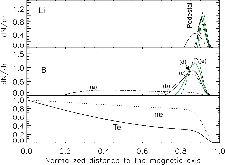Hollow pellet injection for magnetic fusion
- Los Alamos National Lab. (LANL), Los Alamos, NM (United States)
- Univ. of California, San Diego, La Jolla, CA (United States)
- Chinese Academy of Sciences, Hefei (China); Princeton Plasma Physics Lab. (PPPL), Princeton, NJ (United States)
- Chinese Academy of Sciences, Hefei (China)
- General Atomics, San Diego, CA (United States)
- Princeton Plasma Physics Lab. (PPPL), Princeton, NJ (United States)
- Lawrence Livermore National Lab. (LLNL), Livermore, CA (United States)
The precise delivery of mass to burning plasmas is an area of growing interest in magnetic fusion (MF). The amount of mass that is necessary and sufficient can vary depending on such parameters as the type of atoms involved, the type of applications, plasma conditions, mass injector, and injection timing. Motivated by edge localized mode (ELM) control in H-mode plasmas, disruption mitigation and other applications in MF, we report the progress and new possibilities in mass delivery based on hollow pellets. Here, a hollow pellet refers to a spherical shell mass structure with a hollow core. Based on an empirical model of pellet ablation, coupled with BOUT++ simulations of the ELM triggering threshold, hollow pellets are found to be attractive in comparison with solid spheres for ELM control. By using hollow pellets, it is possible to tailor mass delivery to certain regions of edge plasmas while minimizing core contamination and reducing the total amount of mass needed. We also include the experimental progress in mass delivery experiments, in situ diagnostics and hollow pellet fabrication, and emphasize new experimental possibilities for ELM control based on hollow pellets. A related application is the disruption mitigation scheme using powder encapsulated inside hollow shells. Further experiments will also help to resolve known discrepancies between theoretical predictions and experiments in using mass injection for ELM control and leading to better predictive models for ELM stability and triggering.
- Research Organization:
- Lawrence Livermore National Laboratory (LLNL), Livermore, CA (United States); Princeton Plasma Physics Laboratory (PPPL), Princeton, NJ (United States); Los Alamos National Laboratory (LANL), Los Alamos, NM (United States)
- Sponsoring Organization:
- USDOE National Nuclear Security Administration (NNSA); USDOE Office of Science (SC), Fusion Energy Sciences (FES); National Key Research and Development Program of China; National Natural Science Foundation of China (NSFC)
- Contributing Organization:
- Fusion Energy Sciences long-pulse tokamak program through the Triad National Security, LLC (‘Triad’) contract # 89233218CNA000001; National Key Research Development Program of China (2017YFA0402500) and the National Nature Science Foundation of China (11625524).
- Grant/Contract Number:
- AC52-07NA27344; 89233218CNA000001; AC02-09CH11466; FC02-04ER54698; 2017YFA0402500; 11625524
- OSTI ID:
- 1959464
- Alternate ID(s):
- OSTI ID: 1562483; OSTI ID: 1571597
- Report Number(s):
- LLNL-JRNL-844699; LA-UR-18-31744; 1068126; TRN: US2312867
- Journal Information:
- Nuclear Fusion, Vol. 59, Issue 8; ISSN 0029-5515
- Publisher:
- IOP ScienceCopyright Statement
- Country of Publication:
- United States
- Language:
- English
Web of Science
Similar Records
ELM elimination with Li powder injection in EAST discharges using the tungsten upper divertor
Construction and experimental tests of the high frequency pellet injection system on EAST tokamak













